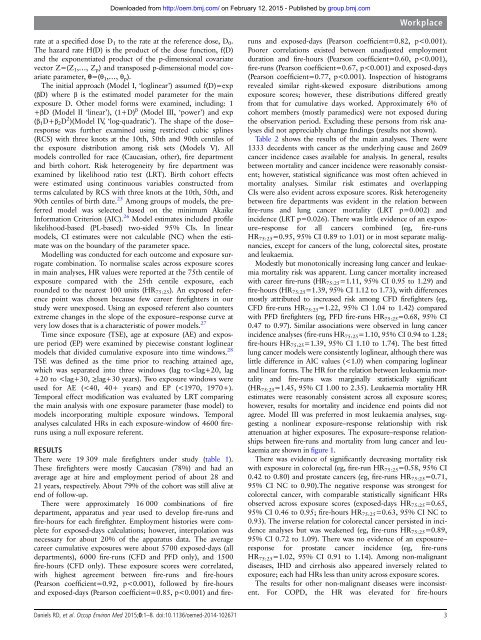Daniels-et-al-(2015)
Daniels-et-al-(2015)
Daniels-et-al-(2015)
You also want an ePaper? Increase the reach of your titles
YUMPU automatically turns print PDFs into web optimized ePapers that Google loves.
Downloaded from http://oem.bmj.com/ on February 12, <strong>2015</strong> - Published by group.bmj.com<br />
Workplace<br />
rate at a specified dose D 1 to the rate at the reference dose, D 0 .<br />
The hazard rate H(D) is the product of the dose function, f(D)<br />
and the exponentiated product of the p-dimension<strong>al</strong> covariate<br />
vector Z=(Z 1 ,…, Z p ) and transposed p-dimension<strong>al</strong> model covariate<br />
param<strong>et</strong>er, θ=(θ 1 ,…, θ p ).<br />
The initi<strong>al</strong> approach (Model I, ‘loglinear’) assumed f(D)=exp<br />
(βD) where β is the estimated model param<strong>et</strong>er for the main<br />
exposure D. Other model forms were examined, including: 1<br />
+βD (Model II ‘linear’), (1+D) β (Model III, ‘power’) and exp<br />
(β 1 D+β 2 D 2 )(Model IV, ‘log-quadratic’). The shape of the dose–<br />
response was further examined using restricted cubic splines<br />
(RCS) with three knots at the 10th, 50th and 90th centiles of<br />
the exposure distribution among risk s<strong>et</strong>s (Models V). All<br />
models controlled for race (Caucasian, other), fire department<br />
and birth cohort. Risk h<strong>et</strong>erogeneity by fire department was<br />
examined by likelihood ratio test (LRT). Birth cohort effects<br />
were estimated using continuous variables constructed from<br />
terms c<strong>al</strong>culated by RCS with three knots at the 10th, 50th, and<br />
90th centiles of birth date. 25 Among groups of models, the preferred<br />
model was selected based on the minimum Akaike<br />
Information Criterion (AIC). 26 Model estimates included profile<br />
likelihood-based (PL-based) two-sided 95% CIs. In linear<br />
models, CI estimates were not c<strong>al</strong>culable (NC) when the estimate<br />
was on the boundary of the param<strong>et</strong>er space.<br />
Modelling was conducted for each outcome and exposure surrogate<br />
combination. To norm<strong>al</strong>ise sc<strong>al</strong>es across exposure scores<br />
in main an<strong>al</strong>yses, HR v<strong>al</strong>ues were reported at the 75th centile of<br />
exposure compared with the 25th centile exposure, each<br />
rounded to the nearest 100 units (HR 75:25 ). An exposed reference<br />
point was chosen because few career firefighters in our<br />
study were unexposed. Using an exposed referent <strong>al</strong>so counters<br />
extreme changes in the slope of the exposure–response curve at<br />
very low doses that is a characteristic of power models. 27<br />
Time since exposure (TSE), age at exposure (AE) and exposure<br />
period (EP) were examined by piecewise constant loglinear<br />
models that divided cumulative exposure into time windows. 28<br />
TSE was defined as the time prior to reaching attained age,<br />
which was separated into three windows (lag to


